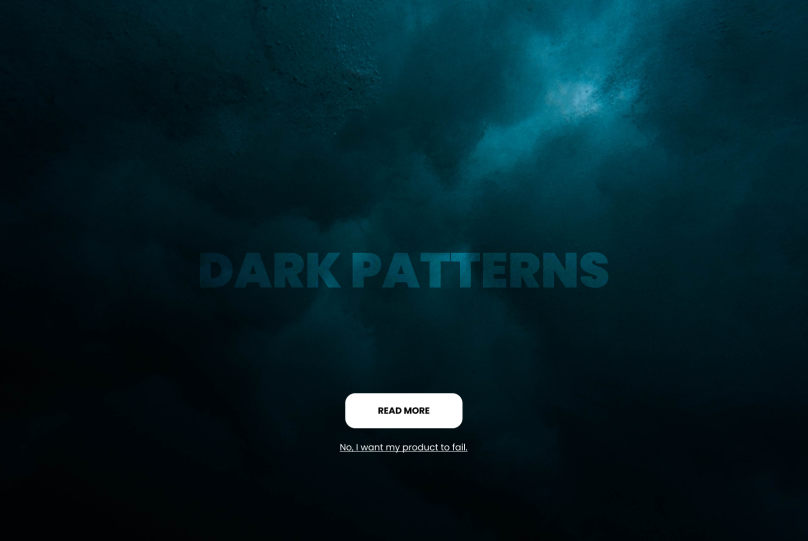What is a dark pattern?
In today’s article, we will talk about the scourge of user interfaces – dark patterns that turn routine tasks into a constant struggle for your own wallet and personal data and what can go wrong with your product, when you don't pay attention to design.
The term dark pattern, which can be translated from English as "dark scheme", hides a set of techniques and design solutions that force users to spend more money on the Internet and obey the requirements of developers of websites and applications.
These schemes force us to subscribe to unnecessary email newsletters, pay money for a subscription that cannot be canceled without dancing with a tambourine, and answer a thousand and one questions in order to refuse to buy an imposed product. Dark patterns confuse us and prevent us from comfortably using Internet services and programs. And they're everywhere.

A little bit about Nielsen's 10 heuristics
Back in the 80s, interface designer Jacob Nielsen and his colleague developed 10 principles that should be followed by those who create interfaces for people. These are the principles of accessibility of information, saying that the program itself should push users to the right decisions and simplify their lives.
Dark patterns are a complete contradiction to Nielsen's heuristics.
Types of dark patterns
Fraudulent schemes (and they are fraudulent, there is no other way to call them) are a long-standing phenomenon, and it is not directly connected to the Internet. Credit agreements, messages about promotions and discounts, terms of tariffs from mobile operators, etc. All people involved in these entities create the most confusing and incomprehensible texts so that in the end the user either did not try to familiarize himself with the terms of service at all or did not understand anything and turned out to be a fool.
On the web, this approach has acquired a planetary scale. Everyone – from small hosts to multinational companies – is cunning and trying to get money out of you, leading by the nose with the help of the notorious dark patterns.
Let's look at a couple of the most common scenarios.
Pressure on pity
When you want to unsubscribe from the services of another service or refuse a "super-profitable" offer, a company that previously tried to seem friendly or serious will try to humiliate you or begin to put pressure on pity.
For example, the popular multitool for SEO specialists OptinMonster offers two possible answers to the proposal to increase the number of email subscribers:
Yes, to gain subscribers.
No, I'm fine with my business losing customers.

Some services and companies are so unwilling to part with you (or rather with your data or money) that they are ready to create extremely complex interfaces, so long as you do not find the right option.
Apple, before abruptly changing its policy towards protecting user privacy, cleverly hid the controls responsible for turning to target on and off.
Some sites in the spirit of ASOS do not provide an opportunity to delete your profile from their site. And resources such as Joey Sturgis Tones create a separate "Unsubscribe from mailing list" button, but completely ignore its purpose (that is, letters from them continue to come to the mail, even if you allegedly unsubscribed).
Disguised advertising
A frequently used trick that helps unscrupulous developers and designers generate additional clicks for their phishing pages and downloads for their useless (without coercion) applications.
A classic example is a fake "Download" button. There is a wonderful Chrome. Browser advertisement on this topic, partially copying the "Download" button under the desired product. At the same time, it is larger, has more visual elements, distracts from the desired button and 100% disorients many visitors to the page.
Automatic subscription renewal
One of the most common variations of fishing money out of users' wallets. It is already a familiar call for everyone to "Sign up for a free trial period, and then we will quietly charge you money without notifying you of the end of the test period." However, here we need to stop in more detail.
Automatically renewed subscriptions as one of the most popular dark patterns you probably have come across in trials, and test periods of using the service, for which money is usually not taken. For example, you are given the opportunity to listen to music on Spotify for free for one month, watch videos without ads on YouTube, read news in the New York Times, etc.
The bottom line is that each (or almost every) trial is accompanied by the connection of a bank card for test payments (a ruble is debited to check whether the card works). This is done in the hope that you will then forget to unpin the card and miss the moment when you need to unsubscribe. As a result, money will be withdrawn from the card.
Is it legal?
In California, there was a case when the New York Times newspaper came under attack by users who were not warned that the subscription to the publication was automatically renewed every month. At the BOTTOM they filed a lawsuit. As a result, the newspaper lost and paid a huge fine.
Similar laws were adopted at the global level. Government authorities in many countries forced services and technology companies to explain the terms of subscription renewal more clearly and intelligibly to customers.
What is the use of dark patterns fraught with?
Loss of reputation, first of all. Even if you manage to leave the court in a white coat, you will not be able to maintain the trust of users. If the project is kept afloat by the use of fraudulent schemes, then its death is a matter of time. A competitor will come who is not trying to brainwash consumers and will take them to himself.
And in the wake of the popularization of "environmental friendliness" on the Internet and the fashion for privacy everywhere, sites and applications that use dark patterns have less and less chance of survival.

How to fix it?
We recall 10 heuristics of Jacob Nielsen and follow them clearly:
We show the key information that users need in the most visual and understandable way.
Use normal speech, not abstruse confusing terms.
Give users the opportunity to cancel their actions at any time.
Stick to the standards and don't force the user to think about whether the same buttons can lead to different actions.
If an error has occurred, explain clearly why it occurred.
Simplify the interface structure as much as possible.
Add advanced features for advanced users.
Stick to restrained aesthetics and sound asceticism when designing interfaces.
Try to build the application so that there is a minimal chance of an error appearing in it. And if it happened, then let the program solve the problem itself, and not burden the user with it.
If you can't make the interface simple enough, then give a brief briefing at the first launch and create documentation.
Instead of a conclusion
“It’s just a matter of time before a competitor comes along who provides a better experience. If your business depends on Dark Patterns to succeed, you’re just leaving yourself open to being disrupted.” Harry Brignull
Dark patterns of any kind harm users and developers. This is something that needs to be eradicated, but eradication is moving too slowly. We can only hope that more and more designers will create good products for which you want to pay money without any coercion, and states will punish you more severely for auto-renewing subscriptions without warning.
Exploring UX, UI, and Graphic Design at Mobile Reality
Dive into the vibrant UX, UI, and graphic design world with Mobile Reality. We're excited to share our expertise and unique insights in these creative fields. Discover the challenges we face and the innovative solutions we craft in the realms of user experience, user interface, and graphic design through our carefully selected collection of articles:
- React Native Techniques for Building Complex UIs
- CX vs UX- Customer vs User Expeirence
- Stages of User Experience Process Explained
- A word about Branding - a key to your company's success
- Enhance Your Design Process with a Software Style Guide
Each article offers a deep dive into the nuances of UX, UI, and graphic design, enhancing your understanding of these crucial aspects of digital creation. If you're considering collaboration in UX/UI design or graphic projects, please get in touch with our sales team for partnership opportunities. Additionally, if you're interested in joining our creative team, we invite you to contact our recruitment department. We are always on the lookout for talented designers who are passionate about crafting exceptional user experiences. Let's connect and explore the potential of creative collaboration!





